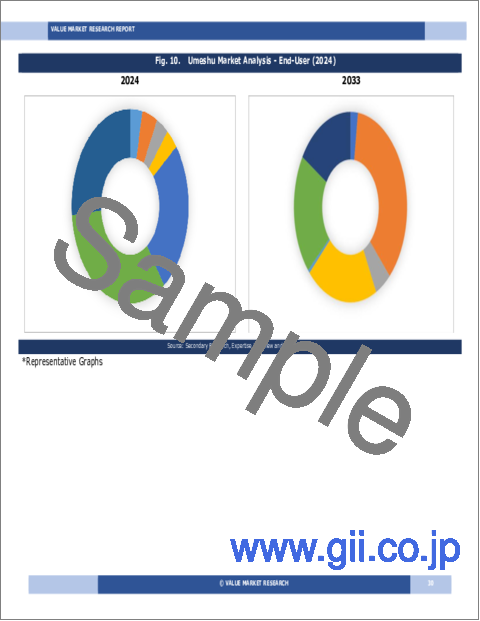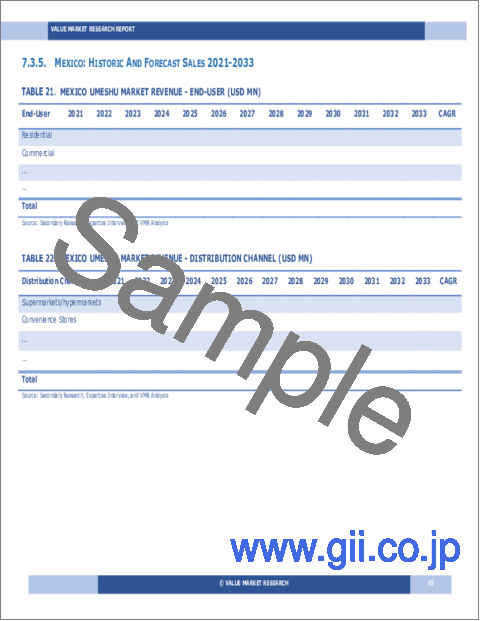|
|
市場調査レポート
商品コード
1676093
梅酒の世界市場調査レポート:産業分析、規模、シェア、成長、動向、2025年から2033年までの予測Global Umeshu Market Research Report- Industry Analysis, Size, Share, Growth, Trends and Forecast 2025 to 2033 |
||||||
カスタマイズ可能
|
|||||||
| 梅酒の世界市場調査レポート:産業分析、規模、シェア、成長、動向、2025年から2033年までの予測 |
|
出版日: 2025年03月01日
発行: Value Market Research
ページ情報: 英文 164 Pages
納期: 即日から翌営業日
|
全表示
- 概要
- 図表
- 目次
世界の梅酒市場規模は、2024年の67億5,000万米ドルから2033年には123億8,000万米ドルに成長すると予測され、2026~2033年の予測期間中の年間平均成長率(CAGR)は6.97%と堅調な伸びを示します。
梅酒市場は、日本の伝統的梅酒の人気が世界的に拡大するにつれて大きく成長しています。梅の果実、砂糖、アルコールから作られる梅酒は、甘くてピリッとした風味で知られ、さまざまな場面で利用できる万能飲料となっています。ユニークで本格的なアルコール飲料への関心の高まりは、工芸品や職人製品の動向と相まって、梅酒の需要を牽引しています。消費者が新しい味覚体験を求め、様々な文化的飲料を探求するにつれ、梅酒市場は拡大すると予想されます。
生産方法と流通における技術の進歩が、梅酒市場の将来を形成しています。発酵技術や品質管理における技術革新は、梅酒の風味と安定性を高め、生産者はより多くの人々にアピールする高品質な製品を作ることができます。さらに、eコマースやオンライン小売プラットフォームの台頭により、消費者がさまざまな地域の梅酒にアクセスしやすくなり、市場の成長をさらに後押ししています。メーカーが新たな風味の組み合わせや包装の選択肢を模索し続けていることから、梅酒市場は従来の消費者だけでなく、新たな層にも普及が進むとみられます。
さらに、健康志向の高まりが梅酒市場に影響を与えています。梅酒はその天然成分や、消化を助けたり抗酸化物質を供給したりといった潜在的な健康効果により、他のアルコール飲料に代わる健康的な飲料として認識されることが多いです。こうした認識が、ユニークな味覚体験を提供しつつ低アルコールの選択肢を求める健康志向の消費者を引き付けています。市場が進化を続ける中、健康に焦点を当てたマーケティング戦略と教育的イニシアチブを統合することが、梅酒を望ましい飲料の選択肢として普及させる成功の鍵となると考えられます。
当社のレポートは、様々な産業や市場に関する包括的かつ実用的な洞察をクライアントに提供するために綿密に作成されています。各レポートは、市場情勢を完全に理解するために、いくつかの重要な要素を含んでいます。
市場概要:市場概要:定義、分類、産業の現状など、市場に関する詳細なイントロダクション。
市場促進要因:市場成長に影響を与える主要促進要因・抑制要因・市場促進要因・課題を詳細に分析します。このセクションでは、技術の進歩、規制の変更、新たな動向などの要因を検証します。
セグメンテーション分析:製品タイプ、用途、エンドユーザー、地域などの基準に基づき、市場を明確なセグメントに内訳。この分析により、各セグメントの業績と将来性を明らかにします。
競合情勢:市場シェア、製品ポートフォリオ、戦略的イニシアティブ、財務実績など、主要市場参入企業の包括的評価。主要企業が採用する競合力学と主要戦略に関する考察を記載しています。
市場予測:過去のデータと現在の市場状況に基づき、一定期間における市場規模と成長動向を予測。これには、定量的分析と将来の市場軌跡を示すグラフ表示が含まれます。
地域分析:地域による市場パフォーマンスを評価し、主要市場や地域動向を明らかにします。地域の市場力学とビジネス機会を理解するのに役立ちます。
新たな動向と機会:現在の市場動向と新たな市場動向、技術革新、潜在的な投資対象セグメントを特定します。将来の市場開拓と成長展望に関する洞察を記載しています。
目次
第1章 序文
第2章 エグゼクティブサマリー
- 市場のハイライト
- 世界市場スナップショット
第3章 梅酒産業分析
- イントロダクション-市場力学
- 市場促進要因
- 市場抑制要因
- 機会
- 産業動向
- ポーターのファイブフォース分析
- 市場の魅力分析
第4章 バリューチェーン分析
- バリューチェーン分析
- 原料分析
- 原料リスト
- 原料メーカー一覧
- 主要原料の価格動向
- 潜在的バイヤーリスト
- マーケティングチャネル
- 直接マーケティング
- 間接マーケティング
- マーケティングチャネル発展動向
第5章 梅酒の世界市場分析:エンドユーザー別
- エンドユーザー別概要
- エンドユーザー別過去・予測データ分析
- 家庭用
- 商用
第6章 梅酒の世界市場分析:流通チャネル別
- 流通チャネル別概要
- 流通チャネル別過去・予測データ分析
- スーパーマーケット/ハイパーマーケット
- コンビニエンスストア
- 小売店
- オンライン
第7章 世界の梅酒市場分析:地域別
- 地域別展望
- イントロダクション
- 北米売上分析
- 概要、実績と予測
- 北米:セグメント別
- 北米:国別
- 米国
- カナダ
- メキシコ
- 欧州売上分析
- 概要、実績と予測
- 欧州:セグメント別
- 欧州:国別
- 英国
- フランス
- ドイツ
- イタリア
- ロシア
- その他の欧州
- アジア太平洋売上分析
- 概要、実績と予測
- アジア太平洋:セグメント別
- アジア太平洋:国別
- 中国
- インド
- 日本
- 韓国
- オーストラリア
- 東南アジア
- その他のアジア太平洋
- ラテンアメリカ売上分析
- 概要、実績と予測
- ラテンアメリカ:セグメント別
- ラテンアメリカ:国別
- ブラジル
- アルゼンチン
- ペルー
- チリ
- その他のラテンアメリカ
- 中東・アフリカ売上分析
- 概要、実績と予測
- 中東・アフリカ:セグメント別
- 中東・アフリカ:国別一覧
- サウジアラビア
- アラブ首長国連邦
- イスラエル
- 南アフリカ
- その他の中東・アフリカ
第8章 梅酒企業の競合情勢
- 梅酒市場の競合
- 提携・協力・契約
- 合併・買収
- 新製品発売
- その他の開発
第9章 企業プロファイル
- 上位企業の市場シェア分析
- 市場集中度
- Choya Umeshu
- Ozeki
- Xsens Technologies BV
- Umenoyado
- Takara Sake
- Jinro
- Creation Food
- Suntory
- Lotte
- Uisuki
- Kiku Masamune
LIST OF TABLES
- Market Snapshot
- Drivers: Impact Analysis
- Restraints: Impact Analysis
- List of Raw Material
- List of Raw Material Manufactures
- Analysis By End-User (USD MN)
- Residential Market Sales By Geography (USD MN)
- Commercial Market Sales By Geography (USD MN)
- Analysis By Distribution Channel (USD MN)
- Supermarkets/hypermarkets Market Sales By Geography (USD MN)
- Convenience Stores Market Sales By Geography (USD MN)
- Retailers Market Sales By Geography (USD MN)
- Online Market Sales By Geography (USD MN)
- Global Umeshu Market Sales By Geography (USD MN)
- North America Market Analysis (USD MN)
- United States Market Analysis (USD MN)
- Canada Market Analysis (USD MN)
- Mexico Market Analysis (USD MN)
- Europe Market Analysis (USD MN)
- Europe Market Estimate By Country (USD MN)
- United Kingdom Market Analysis (USD MN)
- France Market Analysis (USD MN)
- Germany Market Analysis (USD MN)
- Italy Market Analysis (USD MN)
- Russia Market Analysis (USD MN)
- Spain Market Analysis (USD MN)
- Rest of Europe Market Analysis (USD MN)
- Asia Pacific Market Analysis (USD MN)
- China Market Analysis (USD MN)
- Japan Market Analysis (USD MN)
- India Market Analysis (USD MN)
- South Korea Market Analysis (USD MN)
- Australia Market Analysis (USD MN)
- South East Asia Market Analysis (USD MN)
- Rest of Asia Pacific Market Analysis (USD MN)
- Latin America Market Analysis (USD MN)
- Brazil Market Analysis (USD MN)
- Argentina Market Analysis (USD MN)
- Peru Market Analysis (USD MN)
- Chile Market Analysis (USD MN)
- Rest of Latin America Market Analysis (USD MN)
- Middle East & Africa Market Analysis (USD MN)
- Saudi Arabia Market Analysis (USD MN)
- UAE Market Analysis (USD MN)
- Israel Market Analysis (USD MN)
- South Africa Market Analysis (USD MN)
- Rest of Middle East and Africa Market Analysis (USD MN)
- Partnership/Collaboration/Agreement
- Mergers And Acquisition
LIST OF FIGURES
- Research Scope of Umeshu Report
- Market Research Process
- Market Research Methodology
- Global Umeshu Market Size, By Region (USD MN)
- Porters Five Forces Analysis
- Market Attractiveness Analysis By End-User
- Market Attractiveness Analysis By Distribution Channel
- Market Attractiveness Analysis By Region
- Value Chain Analysis
- Global Market Analysis By End-User (USD MN)
- Residential Market Sales By Geography (USD MN)
- Commercial Market Sales By Geography (USD MN)
- Global Market Analysis By Distribution Channel (USD MN)
- Supermarkets/hypermarkets Market Sales By Geography (USD MN)
- Convenience Stores Market Sales By Geography (USD MN)
- Retailers Market Sales By Geography (USD MN)
- Online Market Sales By Geography (USD MN)
- Global Market Sales (USD MN)
- North America Market Sales (USD MN)
- Europe Market Sales (USD MN)
- Asia Pacific Market Sales (USD MN)
- Latin America Market Sales (USD MN)
- Middle East & Africa Market Sales (USD MN)
- Recent Development in Industry
- Top Company Market Share Analysis
- Kindly note that the above listed are the basic tables and figures of the report and are not limited to the TOC.
Global Umeshu Market size is anticipated to grow from USD 6.75 Billion in 2024 to USD 12.38 Billion by 2033, showcasing a robust Compound Annual Growth Rate (CAGR) of 6.97% during the forecast period of 2026 to 2033.
The Umeshu Market is witnessing significant growth as the popularity of this traditional Japanese plum wine expands globally. Umeshu, made from ume fruit, sugar, and alcohol, is known for its sweet and tangy flavor profile, making it a versatile beverage for various occasions. The rising interest in unique and authentic alcoholic beverages, coupled with the growing trend of craft and artisanal products, is driving demand for umeshu. As consumers seek new taste experiences and explore different cultural beverages, the market for umeshu is expected to expand.
Technological advancements in production methods and distribution are shaping the future of the umeshu market. Innovations in fermentation techniques and quality control are enhancing the flavor and consistency of umeshu, allowing producers to create high-quality products that appeal to a broader audience. Additionally, the rise of e-commerce and online retail platforms is making it easier for consumers to access umeshu from various regions, further driving market growth. As manufacturers continue to explore new flavor combinations and packaging options, the umeshu market is likely to see increased adoption among both traditional consumers and new demographics.
Moreover, the growing emphasis on health and wellness is influencing the umeshu market. Umeshu is often perceived as a healthier alternative to other alcoholic beverages due to its natural ingredients and potential health benefits, such as aiding digestion and providing antioxidants. This perception is attracting health-conscious consumers who are looking for lower-alcohol options that still offer a unique taste experience. As the market continues to evolve, the integration of health-focused marketing strategies and educational initiatives will be key drivers of success in promoting umeshu as a desirable beverage choice.
Our reports are meticulously crafted to provide clients with comprehensive and actionable insights into various industries and markets. Each report encompasses several critical components to ensure a thorough understanding of the market landscape:
Market Overview: A detailed introduction to the market, including definitions, classifications, and an overview of the industry's current state.
Market Dynamics: In-depth analysis of key drivers, restraints, opportunities, and challenges influencing market growth. This section examines factors such as technological advancements, regulatory changes, and emerging trends.
Segmentation Analysis: Breakdown of the market into distinct segments based on criteria like product type, application, end-user, and geography. This analysis highlights the performance and potential of each segment.
Competitive Landscape: Comprehensive assessment of major market players, including their market share, product portfolio, strategic initiatives, and financial performance. This section provides insights into the competitive dynamics and key strategies adopted by leading companies.
Market Forecast: Projections of market size and growth trends over a specified period, based on historical data and current market conditions. This includes quantitative analyses and graphical representations to illustrate future market trajectories.
Regional Analysis: Evaluation of market performance across different geographical regions, identifying key markets and regional trends. This helps in understanding regional market dynamics and opportunities.
Emerging Trends and Opportunities: Identification of current and emerging market trends, technological innovations, and potential areas for investment. This section offers insights into future market developments and growth prospects.
SEGMENTATION COVERED IN THE REPORT
By End-User
- Residential
- Commercial
By Distribution Channel
- Supermarkets/hypermarkets
- Convenience Stores
- Retailers
- Online
- COMPANIES PROFILED
- Choya Umeshu
- Ozeki
- Xsens Technologies BV
- Umenoyado
- Takara Sake
- Jinro
- Creation Food
- Suntory
- Lotte
- Uisuki
- Kiku Masamune.
- The above list can be customized.
TABLE OF CONTENTS
1. PREFACE
- 1.1. Report Description
- 1.1.1 Objective
- 1.1.2 Target Audience
- 1.1.3 Unique Selling Proposition (USP) & offerings
- 1.2. Research Scope
- 1.3. Research Methodology
- 1.3.1 Market Research Process
- 1.3.2 Market Research Methodology
2. EXECUTIVE SUMMARY
- 2.1. Highlights of Market
- 2.2. Global Market Snapshot
3. UMESHU INDUSTRY ANALYSIS
- 3.1. Introduction - Market Dynamics
- 3.2. Market Drivers
- 3.3. Market Restraints
- 3.4. Opportunities
- 3.5. Industry Trends
- 3.6. Porters Five Force Analysis
- 3.7. Market Attractiveness Analysis
- 3.7.1 Market Attractiveness Analysis By End-User
- 3.7.2 Market Attractiveness Analysis By Distribution Channel
- 3.7.3 Market Attractiveness Analysis By Region
4. VALUE CHAIN ANALYSIS
- 4.1. Value Chain Analysis
- 4.2. Raw Material Analysis
- 4.2.1 List of Raw Materials
- 4.2.2 Raw Material Manufactures List
- 4.2.3 Price Trend of Key Raw Materials
- 4.3. List of Potential Buyers
- 4.4. Marketing Channel
- 4.4.1 Direct Marketing
- 4.4.2 Indirect Marketing
- 4.4.3 Marketing Channel Development Trend
5. GLOBAL UMESHU MARKET ANALYSIS BY END-USER
- 5.1. Overview By End-User
- 5.2. Historical and Forecast Data Analysis By End-User
- 5.3. Residential Historic and Forecast Sales By Regions
- 5.4. Commercial Historic and Forecast Sales By Regions
6. GLOBAL UMESHU MARKET ANALYSIS BY DISTRIBUTION CHANNEL
- 6.1. Overview By Distribution Channel
- 6.2. Historical and Forecast Data Analysis By Distribution Channel
- 6.3. Supermarkets/hypermarkets Historic and Forecast Sales By Regions
- 6.4. Convenience Stores Historic and Forecast Sales By Regions
- 6.5. Retailers Historic and Forecast Sales By Regions
- 6.6. Online Historic and Forecast Sales By Regions
7. GLOBAL UMESHU MARKET ANALYSIS BY GEOGRAPHY
- 7.1. Regional Outlook
- 7.2. Introduction
- 7.3. North America Sales Analysis
- 7.3.1 Overview, Historic and Forecast Data Sales Analysis
- 7.3.2 North America By Segment Sales Analysis
- 7.3.3 North America By Country Sales Analysis
- 7.3.4 United States Sales Analysis
- 7.3.5 Canada Sales Analysis
- 7.3.6 Mexico Sales Analysis
- 7.4. Europe Sales Analysis
- 7.4.1 Overview, Historic and Forecast Data Sales Analysis
- 7.4.2 Europe By Segment Sales Analysis
- 7.4.3 Europe By Country Sales Analysis
- 7.4.4 United Kingdom Sales Analysis
- 7.4.5 France Sales Analysis
- 7.4.6 Germany Sales Analysis
- 7.4.7 Italy Sales Analysis
- 7.4.8 Russia Sales Analysis
- 7.4.9 Rest Of Europe Sales Analysis
- 7.5. Asia Pacific Sales Analysis
- 7.5.1 Overview, Historic and Forecast Data Sales Analysis
- 7.5.2 Asia Pacific By Segment Sales Analysis
- 7.5.3 Asia Pacific By Country Sales Analysis
- 7.5.4 China Sales Analysis
- 7.5.5 India Sales Analysis
- 7.5.6 Japan Sales Analysis
- 7.5.7 South Korea Sales Analysis
- 7.5.8 Australia Sales Analysis
- 7.5.9 South East Asia Sales Analysis
- 7.5.10 Rest Of Asia Pacific Sales Analysis
- 7.6. Latin America Sales Analysis
- 7.6.1 Overview, Historic and Forecast Data Sales Analysis
- 7.6.2 Latin America By Segment Sales Analysis
- 7.6.3 Latin America By Country Sales Analysis
- 7.6.4 Brazil Sales Analysis
- 7.6.5 Argentina Sales Analysis
- 7.6.6 Peru Sales Analysis
- 7.6.7 Chile Sales Analysis
- 7.6.8 Rest of Latin America Sales Analysis
- 7.7. Middle East & Africa Sales Analysis
- 7.7.1 Overview, Historic and Forecast Data Sales Analysis
- 7.7.2 Middle East & Africa By Segment Sales Analysis
- 7.7.3 Middle East & Africa By Country Sales Analysis
- 7.7.4 Saudi Arabia Sales Analysis
- 7.7.5 UAE Sales Analysis
- 7.7.6 Israel Sales Analysis
- 7.7.7 South Africa Sales Analysis
- 7.7.8 Rest Of Middle East And Africa Sales Analysis
8. COMPETITIVE LANDSCAPE OF THE UMESHU COMPANIES
- 8.1. Umeshu Market Competition
- 8.2. Partnership/Collaboration/Agreement
- 8.3. Merger And Acquisitions
- 8.4. New Product Launch
- 8.5. Other Developments
9. COMPANY PROFILES OF UMESHU INDUSTRY
- 9.1. Top Companies Market Share Analysis
- 9.2. Market Concentration Rate
- 9.3. Choya Umeshu
- 9.3.1 Company Overview
- 9.3.2 Company Revenue
- 9.3.3 Products
- 9.3.4 Recent Developments
- 9.4. Ozeki
- 9.4.1 Company Overview
- 9.4.2 Company Revenue
- 9.4.3 Products
- 9.4.4 Recent Developments
- 9.5. Xsens Technologies BV
- 9.5.1 Company Overview
- 9.5.2 Company Revenue
- 9.5.3 Products
- 9.5.4 Recent Developments
- 9.6. Umenoyado
- 9.6.1 Company Overview
- 9.6.2 Company Revenue
- 9.6.3 Products
- 9.6.4 Recent Developments
- 9.7. Takara Sake
- 9.7.1 Company Overview
- 9.7.2 Company Revenue
- 9.7.3 Products
- 9.7.4 Recent Developments
- 9.8. Jinro
- 9.8.1 Company Overview
- 9.8.2 Company Revenue
- 9.8.3 Products
- 9.8.4 Recent Developments
- 9.9. Creation Food
- 9.9.1 Company Overview
- 9.9.2 Company Revenue
- 9.9.3 Products
- 9.9.4 Recent Developments
- 9.10. Suntory
- 9.10.1 Company Overview
- 9.10.2 Company Revenue
- 9.10.3 Products
- 9.10.4 Recent Developments
- 9.11. Lotte
- 9.11.1 Company Overview
- 9.11.2 Company Revenue
- 9.11.3 Products
- 9.11.4 Recent Developments
- 9.12. Uisuki
- 9.12.1 Company Overview
- 9.12.2 Company Revenue
- 9.12.3 Products
- 9.12.4 Recent Developments
- 9.13. Kiku Masamune
- 9.13.1 Company Overview
- 9.13.2 Company Revenue
- 9.13.3 Products
- 9.13.4 Recent Developments





